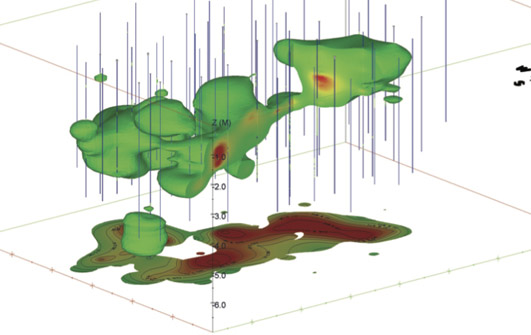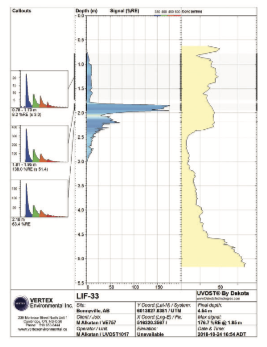
Overview
 An old rail storage yard located in Bonnyville, Alberta was operating for years prior to a laser induced fluorescence (LIF) investigation being completed. After traditional site investigations, light non-aqueous phase liquid (LNAPL) was discovered in in several monitoring wells. After this LNAPL was discovered, it was evident significant data gaps remained in the vertical and horizontal delineation LNAPL impacts across the Site.
An old rail storage yard located in Bonnyville, Alberta was operating for years prior to a laser induced fluorescence (LIF) investigation being completed. After traditional site investigations, light non-aqueous phase liquid (LNAPL) was discovered in in several monitoring wells. After this LNAPL was discovered, it was evident significant data gaps remained in the vertical and horizontal delineation LNAPL impacts across the Site.
The Vertex Approach
Vertex mobilized High Resolution Site Characterization (HRSC) tools to the site for rapid and detailed in-situ delineation. The LIF was deployed to delineate the horizontal and vertical extents of the LNAPL plume in the subsurface across the Site. The LIF was able to determine where the bulk of the LNAPL plume was located and how the depths changed over the Site. It was suspected that the LNAPL impacts would have more of diesel type signature, however the results from the LIF investigation revealed that the LNAPL signature resembled more of a gasoline or lighter ended petroleum product. The LIF data was able to help characterize the suspected type of product and identify areas where more focused confirmatory investigation and remediation activities can be applied for Site closure.
Outcome
The LIF deployed during normal working hours for three (3) days to delineate LNAPL impacts in the subsurface. Vertex was able to profile fifty-six (56) unique locations for a total of 243 vertical meters with the LIF averaging over 80 vertical meters of detailed profiling at the Site per day. The results from the LIF survey revealed that this historic LNAPL plume was isolated on-Site. The project was collected on-time and on-budget.

